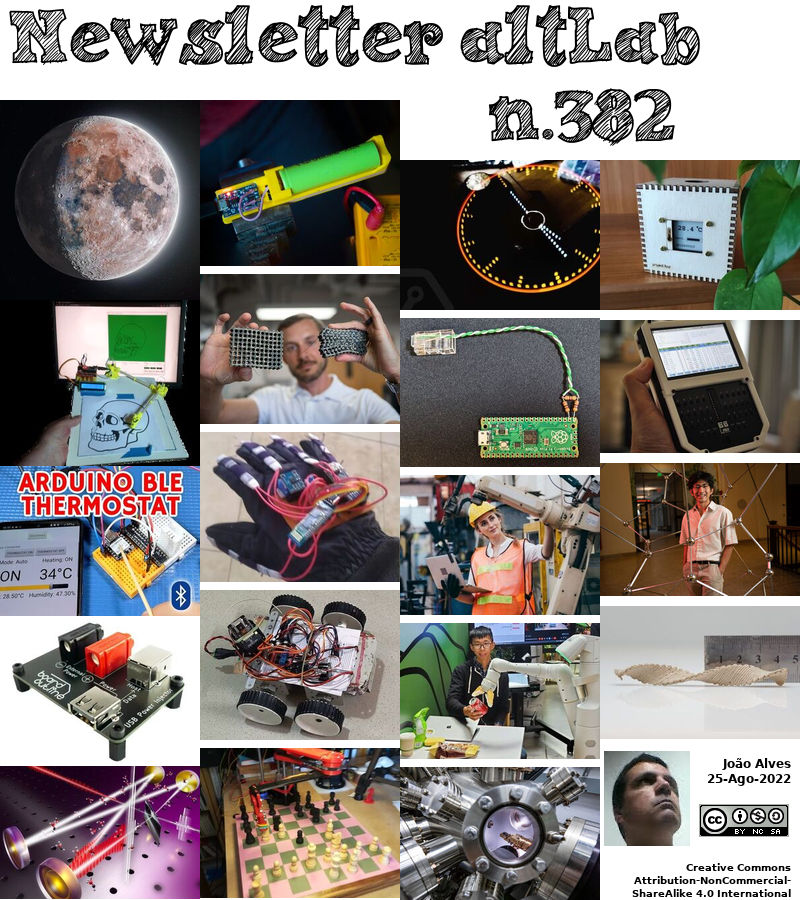2022-08-25 - Nº 382
Editorial
Esta é a Newsletter Nº 382 que se apresenta com o mesmo formato que as anteriores. Se gostar da Newsletter partilhe-a!
Todas as Newsletters encontram-se indexadas no link.
Esta Newsletter tem os seguintes tópicos:
Faz hoje anos que nascia, em 1877, o inventor norte-americano Joshua Lionel Cowen. Ele ficou conhecido pela invenção de comboios modelo eléctricos. Aos 18 anos, tinha inventado um rastilho para acender o pó de magnésio para fotografia com flash, que o Departamento da Marinha lhe comprou para ser um rastilho para detonar minas submarinas. Ele concebeu uma luz de tubo de bateria, mas sem aplicação prática. (O seu parceiro, Conrad Hubert, a quem deu os direitos melhorou-o e fundou a Eveready Flashlight Company). Aos 22 anos de idade, criou uma locomotiva de comboios movida a bateria, destinada apenas como atraidor de atenção para outras mercadorias na montra de uma loja. Para sua surpresa, muitos clientes queriam comprar o comboio de brinquedo. Assim, fundou uma empresa modelo de caminhos-de-ferro.
Por fim, faz hoje anos que nascia, em 1910, o inventor norte-americano Arnold Neustadter. Ele inventou o Rolodex, um ficheiro de cartas rotativas por ordem alfabética com uma embraiagem com rolamentos de esferas. Ele inventou o dispositivo nos anos 40 com a ajuda de um engenheiro que desenvolveu a caixa cilíndrica. Neustadter especializou-se em tecnologia de escritório, inventando também o Swivodex, um tinteiro à prova de derramamento e o Clipodex, uma ferramenta de ditado de joelho.
Há trinta e três anos atrás, a 25 de Agosto de 1989, a nave espacial Voyager 2 da NASA fez um voo de aproximação a Neptuno. Deu à humanidade o seu primeiro grande plano do 8º planeta do nosso sistema solar. Também marcou o fim da Grande Viagem da missão Voyager aos 4 planetas gigantes do sistema solar, Júpiter, Saturno, Urano e Neptuno.
Há 31 anos era anunciado publicamente, por Linus Torvalds, o Linux. A sua intenção de criar o Linux como um sistema operativo livre, como um hobby, nada de profissional, e apenas para processadores intel 386/486. Passados estes anos todos sabemos a importância e impacto que este sistema tem no mundo actual e a forma humilde como nasceu. Sendo usado em todo os smartphones Android, routers, set-top-boxes, servidores, Desktops e nos 500 mais rápidos super-computadores, trata-se de um software bastante complexo e que está presente, ainda que escondido, nas nossas vidas.
Na Newsletter desta semana apresentamos diversas noticias, artigos científicos, projetos de maker e alguns vídeos interessantes. É apresentada a revista MagPI Magazine nº121 de Setembro e o livro "Build a Raspberry Pi Media Player".
 João Alves ([email protected])
João Alves ([email protected])
O conteúdo da Newsletter encontra-se sob a licença  Creative Commons Attribution-NonCommercial-ShareAlike 4.0 International License.
Creative Commons Attribution-NonCommercial-ShareAlike 4.0 International License.
Novidades da Semana
Outras Notícias

NASA Scientists Help Probe Dark Energy by Testing Gravity
"Could one of the biggest puzzles in astrophysics be solved by reworking Albert Einstein’s theory of gravity? A new study co-authored by NASA scientists says not yet. The universe is expanding at an accelerating rate, and scientists don’t know why. This phenomenon seems to contradict everything researchers understand about gravity’s effect on the cosmos: It’s as if you threw an apple in the air and it continued upward, faster and faster. The cause of the acceleration, dubbed dark energy, remains a mystery. A new study from the international Dark Energy Survey, using the Victor M. Blanco 4-meter Telescope in Chile, marks the latest effort to determine whether this is all simply a misunderstanding: that expectations for how gravity works at the scale of the entire universe are flawed or incomplete." [...]

Toshiba Releases Stepping Motor Driver IC That Contributes to Saving Space on Circuit Boards
"Toshiba Electronic Devices & Storage Corporation ("Toshiba") has expanded its lineup of stepping motor driver ICs with the launch of “TB67S549FTG,” a stepping motor driver IC housed in a small package, with built-in constant-current control that does not require external circuit components. The new driver contributes to saving space on circuit boards and is suited for industrial equipment such as office automation and financial equipment. Shipments start today. TB67S549FTG uses Toshiba’s DMOS FET[1] for its output power transistor, and features a motor output voltage rating of 40V and a motor output current rating of 1.5A[2]. Use of the QFN24 package reduces the mounting area to about 64% of the QFN32 package used for Toshiba’s current product, TB67S539FTG. This helps save space on circuit boards." [...]
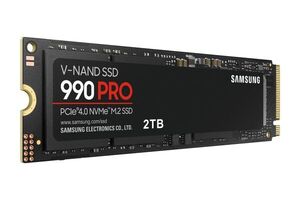
Samsung Electronics Unveils High-Performance 990 PRO SSD Optimized for Gaming and Creative Applications
"Blazing speeds of the 990 PRO cut load times and increase game responsiveness while its thermal control solutions keep the drive at optimal temperature for uninterrupted play Samsung Electronics, the world leader in advanced memory technology, today announced the 990 PRO, the company’s high-performance NVMe SSD based on PCIe 4.0. Delivering lightning-fast speeds and superior power efficiency, the new SSD is optimized for graphically demanding games and other intensive tasks including 3D rendering, 4K video editing and data analysis. “With continuing innovations in gaming, 4K and 8K technology as well as AI-driven applications, consumers’ need for high-performance storage is growing exponentially,” said KyuYoung Lee, Vice President of the Memory Brand Product Biz Team at Samsung Electronics. “The 990 PRO provides an optimal balance of speed, power efficiency and reliability, making it an ideal choice for avid gamers and creative professionals seeking uninterrupted work and play.” Extreme Performance for an Immersive Gameplay Experience Featuring Samsung’s latest V-NAND and a new proprietary controller, the 990 PRO series offers the highest speed currently available from the PCIe 4.0 interface.1 The SSD delivers sequential read and write speeds of up to 7,450 megabytes per second (MB/s) and 6,900 MB/s, respectively, while random read and write speeds come in at up to 1,400K and 1,550K IOPS,2 respectively. With up to a 55% improvement in random performance over the 980 PRO, the 990 PRO is particularly well-suited for heavy gaming as well as creative and productivity tasks. High-performance NVMe SSDs are also critical in reaping the full benefits of the latest game console and gaming technologies." [...]

NXP’s S32 Platform Accelerates with Strong Global Automotive OEM Adoption
"NXP Semiconductors (NASDAQ: NXPI) today announced expanded and strong customer engagements for its entire S32 family of domain and zonal automotive processors. This includes a major automotive OEM’s selection of NXP’s S32 family of automotive processors and microcontrollers to be used across its fleet of future vehicles, beginning mid-decade. The resulting multi-year supply agreement spans the S32 family, including the upcoming 5nm ASIL-D processors. This includes several recent awards with leading automotive OEMs in Europe, the Americas, Asia and China and highlights the appeal and traction of the S32 platform for software-defined vehicles (SDV). Carmakers face significant challenges in laying the foundation for continued automotive innovation, incorporating connectivity, safety and electrification into the software-defined vehicles of the future. OEMs must integrate a hundred or more processors across their vehicles, mine the valuable data of dispersed electronic control units and address the exponential growth of software in vehicles." [...]
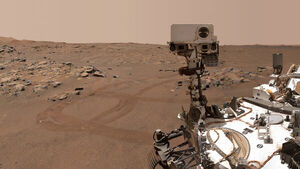
NASA’s Perseverance Makes New Discoveries in Mars’ Jezero Crater
"The rover found that Jezero Crater’s floor is made up of volcanic rocks that have interacted with water. Scientists got a surprise when NASA’s Perseverance Mars rover began examining rocks on the floor of Jezero Crater in spring of 2021: Because the crater held a lake billions of years ago, they had expected to find sedimentary rock, which would have formed when sand and mud settled in a once-watery environment. Instead, they discovered the floor was made of two types of igneous rock – one that formed deep underground from magma, the other from volcanic activity at the surface. The findings are described in four new papers published Thursday, Aug. 25. In Science, one offers an overview of Perseverance’s exploration of the crater floor before it arrived at Jezero’s ancient river delta in April 2022; a second study in the same journal details distinctive rocks that appear to have formed from a thick body of magma. The other two papers, published in Science Advances, detail the unique ways that Perseverance’s rock-vaporizing laser and ground-penetrating radar established that igneous rocks cover the crater floor." [...]

How 2 astrophotographers teamed up to capture a stellar image of the moon
"Two astrophotographers have teamed up to produce an out-of-this-world photo of the moon, capturing over 200,000 shots to create a single image. Andrew McCarthy and Connor Matherne collaborated last November to push their photography skills to the limit. Their finished product was posted online Saturday, and is currently gaining lots of attention on Reddit. The two stargazers first connected over Reddit and then Instagram, sharing and commenting on each other's work over the past three or four years. After recognizing one another's strengths in photography, they decided to team up for a photoshoot of Earth's moon. "When he and I put our heads together we were able to make something a little off brand for both of us, which is cool," McCarthy told NPR." [...]

SpaceX launches 53 more Starlink satellites, lands rocket at sea again
"SpaceX launched another big batch of its Starlink internet satellites to orbit today (Aug. 19) and also aced a rocket landing at sea. A SpaceX Falcon 9 rocket carrying 53 Starlink spacecraft lifted off from Cape Canaveral Space Force Station in Florida today at, appropriately enough, 3:21 p.m. EDT (1921 GMT). About nine minutes into the mission, the Falcon 9's first stage came back to Earth for a vertical touchdown on the SpaceX droneship A Shortfall of Gravitas, which was stationed in the Atlantic Ocean off the Florida coast. It was the ninth launch and landing for this particular Falcon 9 first stage, according to a SpaceX mission description(opens in new tab). The rocket's upper stage, meanwhile, continued its way upward, eventually deploying the 53 satellites into low Earth orbit as planned a little over 15 minutes after launch, SpaceX confirmed via Twitter(opens in new tab). SpaceX has already launched more than 3,000 spacecraft for its Starlink constellation, which beams broadband service to customers around the globe." [...]
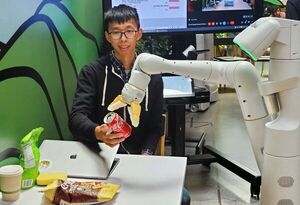
OK Google, get me a Coke: AI giant demos soda-fetching robots
"Alphabet Inc's (GOOGL.O) Google is combining the eyes and arms of physical robots with the knowledge and conversation skills of virtual chatbots to help its employees fetch soda and chips from breakrooms with ease. The mechanical waiters, shown in action to reporters last week, embody an artificial intelligence breakthrough that paves the way for multipurpose robots as easy to control as ones that perform single, structured tasks such as vacuuming or standing guard. Google robots are not ready for sale. They perform only a few dozen simple actions, and the company has not yet embedded them with the "OK, Google" summoning feature familiar to consumers. While Google says it is pursuing development responsibly, adoption could ultimately stall over concerns such as robots becoming surveillance machines, or being equipped with chat technology that can give offensive responses, as Meta Platforms Inc (META.O) and others have experienced in recent years. Microsoft Corp (MSFT.O) and Amazon.com Inc (AMZN.O) are pursuing comparable research on robots." [...]

A New Era of Chipmaking to Meet the World’s Demand for Compute
"Intel CEO Pat Gelsinger details how advanced compute and packaging are needed to meet the world’s insatiable demand for compute and implement fully immersive digital experiences at Hot Chips 34. At Hot Chips 34, Intel highlights the latest architectural and packaging innovations enabling the 2.5D and 3D tile-based chip designs that will bring about a new era in chipmaking and propel Moore’s Law forward for years to come. In Intel’s first Hot Chips CEO keynote since Gordon Moore’s in 1995, Intel CEO Pat Gelsinger shared the company’s path for continuing its relentless pursuit of more powerful compute, providing details from across the company’s upcoming portfolio, including Meteor Lake, Ponte Vecchio GPU, Intel® Xeon® D-2700 and 1700, and FPGAs, and outlining its new systems foundry model. The industry is entering a new golden age of semiconductors – an era in chipmaking that requires a shift from the traditional foundry model mindset to a systems foundry. Beyond supporting traditional wafer manufacturing, Intel’s systems foundry model incorporates advanced packaging, an open chiplet ecosystem and software components, to assemble and deliver systems in a package that meet the world’s insatiable demand for compute power and fully immersive digital experiences. Intel is also addressing industry demand with continued advances in process technology and tile-based design." [...]
Ciência e Tecnologia
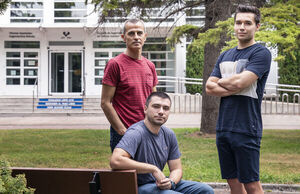
Neural networks being used to improve the performance of high-power wind turbines
"They predict several flow control devices designed for wind turbines fairly reliably and much more rapidly. Research at the Vitoria-Gasteiz Faculty of Engineering of the UPV/EHU has used convolutional neural networks to predict airflow characteristics in the aerodynamic profiles of high-power wind turbines, and has shown that flow control devices can be studied using these neural networks, with tolerable errors and a reduction in computational time of four orders of magnitude. The study has been published by Scientific Reports - NATURE. Wind energy has become an important source of electricity generation and aims to achieve a cleaner, more sustainable energy model. However, in order to compete with conventional energy resources, the performance of wind turbines needs to be improved. To do this, flow control devices are deployed on the aerofoils to improve the aerodynamic efficiency of the wind turbine rotors: “So, with the same wind turbine you can produce more megawatts, the cost per megawatt hour is reduced, and when that is transferred, for example, to an offshore wind turbine (which is huge), means that the implementation cost is negligible, but the aerodynamic improvement may be in the region of 8 or 10 %,” explained Unai Fernández-Gámiz, lecturer in the Department of Nuclear Engineering and Fluid Mechanics of the UPV/EHU-University of the Basque Country." [...]
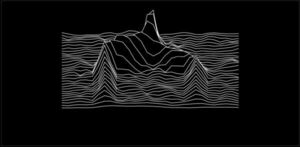
A quantum pump without the crank
"ETH physicists demonstrate how atoms can be pumped through a synthetic crystal without having to apply external periodic driving. These experiments combine several key aspects of quantum many-body physics in unexpected ways, thus paving a novel path to understanding and creating exotic states of quantum matter. Pumps, in a nutshell, are devices that use cyclic motion to attain the steady transport of some cargo. In a bicycle pump, the repeated up and down strokes of a piston create air flow. In an Archimedean screw pump (pictured below), water is transferred between reservoirs by turning a crank. Related concepts have been explored as well in quantum systems, in particular for transporting electrons one by one through solid-state materials, thereby generating a quantised current." [...]

From RHIC to the EIC: Taking Our Exploration of Matter to the Next Frontier
"The nuclear physics research programme at the U.S. Department of Energy’s (DOE) Brookhaven National Laboratory is entering an exciting time. After completing its 22nd successful physics run, the Relativistic Heavy Ion Collider (RHIC), a DOE Office of Science user facility, will be getting a brand-new house-sized particle detector. This new detector, known as sPHENIX – together with RHIC’s newly enhanced STAR detector – will greatly advance physicists’ ability to study subtle details of quark-gluon plasma (QGP) – a remarkable form of matter that filled the early Universe. RHIC recreates tiny specks of this early-Universe particle soup thousands of times each second by colliding the nuclei of atoms at nearly the speed of light. Over the next three years, sPHENIX and STAR will provide unprecedented views of the primordial plasma, in which the most fundamental building blocks of visible matter – quarks and gluons – flow like a nearly perfect liquid with virtually no resistance. Those studies will complete RHIC’s mission to unravel the mysteries of QGP, including how it evolved nearly 14 billion years ago into the protons and neutrons that make up the nuclei of atoms." [...]
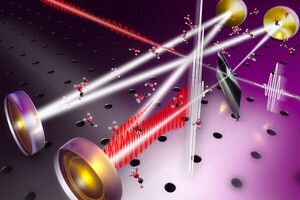
Laser physics: Pumping up the music of molecules
"Laser physicists have used an optical resonator to amplify the characteristic vibrations of molecules excited by laser pulses in such a way that their identification becomes possible even at very low concentrations. Sensitive animal noses can sniff out trace particles, such as volatile organic compounds, in the ambient air. Humans, on the other hand, are developing innovative technologies for this purpose, such as optical spectroscopy. This uses laser light to detect the molecular composition of gases. It opens up the possibility of even surpassing these "smelling" successes - also for substances that animal noses cannot perceive at all. Today, the "olfactory power" of spectroscopy does not yet exploit its potential." [...]
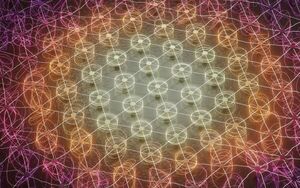
Collective actuation of an elastic network of mini-robots
"The physics of collective motion has been well-studied for the last thirty years. Until now, scientists have focused on the study of ‘fluid’ movements, such as those of flocks of birds or schools of fish. Using an ingenious experimental device, researchers from the University of Amsterdam and the Gulliver laboratory (ESPCI Paris-PSL / CNRS) have revealed the possibility of collective movements in elastic solid structures. Their work sheds light on the mechanism and parameters that control this so-called ‘collective actuation’. This work is published in the journal Nature Physics. The collaboration includes the team of Olivier Dauchot, a CNRS researcher, and the Amsterdam group of Corentin Coulais." [...]
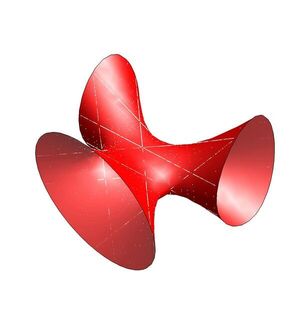
Rational points and new dimensions
"How can you solve equations that define not ‘just’ curves, but also two-dimension surfaces or even higher-dimensional objects? That’s the big question that mathematician Martin Bright and his team will be trying to answer. They’ve received a NWO Science-XL grant of 2.8 million euros. ‘Ever since Descartes gave us x- and y-coordinates, it has been possible to use algebraic equations to describe geometric objects,’ says Bright. ‘When at school you write down the equation of a straight line or circle, that’s what you’re doing. However, in the past century the methods for applying “geometric” constructions to study these equations have vastly broadened, leading to many breakthroughs." [...]
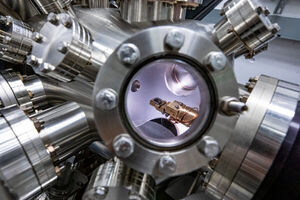
A Faster Way to Study 2D Materials for Next-Generation Quantum and Electronic Devices
"New approach leverages artificial intelligence to augment automated experiments. Two-dimensional materials, which consist of a single layer of atoms, exhibit unusual properties that could be harnessed for a wide range of quantum and microelectronics systems. But what makes them truly special are their flaws. “That’s where their true magic lies,” said Alexander Weber-Bargioni at the Department of Energy’s Lawrence Berkeley National Laboratory (Berkeley Lab). Defects down to the atomic level can influence the material’s macroscopic function and lead to novel quantum behaviors, and there are so many kinds of defects that researchers have barely begun to understand the possibilities. One of the biggest challenges in the field is systematically studying these defects at relevant scales, or with atomic resolution." [...]

Quantum AI breakthrough: theorem shrinks appetite for training data
"Rigorous math proves neural networks can train on minimal data, providing ‘new hope’ for quantum AI and taking a big step toward quantum advantage. Training a quantum neural network requires only a small amount of data, according to a new proof that upends previous assumptions stemming from classical computing’s huge appetite for data in machine learning, or artificial intelligence. The theorem has several direct applications, including more efficient compiling for quantum computers and distinguishing phases of matter for materials discovery. “Many people believe that quantum machine learning will require a lot of data. We have rigorously shown that for many relevant problems, this is not the case,” said Lukasz Cincio, a quantum theorist at Los Alamos National Laboratory and co-author of the paper containing the proof published in the journal Nature Communications. “This provides new hope for quantum machine learning." [...]
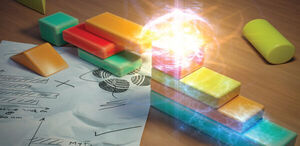
A reflection on the real world
"A simple reordering of the layers in solar-cell modules can help improve efficiency. A solar-cell module that mitigates cell-to-module losses has been developed by KAUST researchers following a rethink of the module’s optical design and how it should be stacked. Research laboratories around the world are working to constantly improve the efficiency of solar cells. But using these devices in the real world represents an extra challenge. For example, solar cells need to be incorporated into modules that can protect the sensitive materials from harsh environments. These modules can reduce the power conversion efficiency, thus losing the performance gains so diligently won in the laboratory." [...]
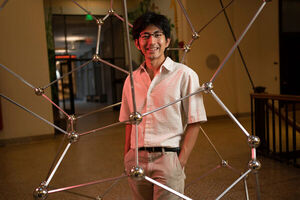
Building better batteries, faster
"PhD student Pablo Leon uses machine learning to expedite research on novel battery materials, while helping newer students navigate graduate school. To help combat climate change, many car manufacturers are racing to add more electric vehicles in their lineups. But to convince prospective buyers, manufacturers need to improve how far these cars can go on a single charge. One of their main challenges? Figuring out how to make extremely powerful but lightweight batteries. Typically, however, it takes decades for scientists to thoroughly test new battery materials, says Pablo Leon, an MIT graduate student in materials science." [...]
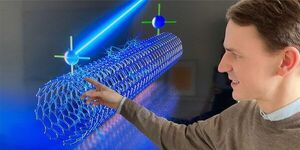
Building chemical sensors to combat climate crisis
"The therapy our ailing planet needs is a major change in energy and agricultural practices, and improved monitoring. Máté Bezdek, formerly a researcher at MIT and now an assistant professor at the LAC / D-CHAB, is addressing these global challenges with molecular, sustainable solutions. In an interview, he talks about how to capture in real time what has remained hidden so far, why one should be able to explain complex research in three minutes, and what makes Switzerland a superpragmatic place. A pair of carefully placed sneakers stands near the front door, an impressively large monitor on the conference table, and a few boxes full of equipment in the back corner of the office. They are subtle hints about the young man who has moved into this office in HCI: an inorganic chemist who still works in the lab in sneakers and wants to be a role model for his team; someone who likes to exchange ideas at the meeting table and who has traveled far for his goals. Last year, Máté Bezdek moved to Switzerland from the US with his wife." [...]

A new concept for low-cost batteries
"Made from inexpensive, abundant materials, an aluminum-sulfur battery could provide low-cost backup storage for renewable energy sources. As the world builds out ever larger installations of wind and solar power systems, the need is growing fast for economical, large-scale backup systems to provide power when the sun is down and the air is calm. Today’s lithium-ion batteries are still too expensive for most such applications, and other options such as pumped hydro require specific topography that’s not always available. Now, researchers at MIT and elsewhere have developed a new kind of battery, made entirely from abundant and inexpensive materials, that could help to fill that gap. The new battery architecture, which uses aluminum and sulfur as its two electrode materials, with a molten salt electrolyte in between, is described today in the journal Nature, in a paper by MIT Professor Donald Sadoway, along with 15 others at MIT and in China, Canada, Kentucky, and Tennessee. “I wanted to invent something that was better, much better, than lithium-ion batteries for small-scale stationary storage, and ultimately for automotive [uses],” explains Sadoway, who is the John F. Elliott Professor Emeritus of Materials Chemistry." [...]

To Remove CO2 From the Atmosphere, Imagine the Possibilities
"Computer simulation methods from NIST help speed up the search for carbon capture materials. In an effort to reduce the risks from climate change, NIST scientists have set out to discover new materials that can draw planet-warming carbon dioxide (CO2) out of the atmosphere, a technique called “direct air capture.” Direct air capture materials already exist, but they either cost too much money or consume too much energy to be deployed on a global scale. NIST scientists are using computer simulations to rapidly screen hypothetical materials that have never been synthesized but that might have just the right physical properties to make this technology scalable. “The traditional way of screening materials is to synthesize them, then test them in the lab, but that is very slow going,” said NIST chemical engineer Vincent Shen. “Computer simulations speed up the discovery process immensely.” Shen and his colleagues are also developing new computational methods that will accelerate the search even more. "Our goal is to develop more efficient modeling methods that extract as much information out of a simulation as possible,” Shen said." [...]

Boosting the single photon rate for quantum communication
"A new experiment performed at the University of Innsbruck in collaboration with researchers from Bayreuth, Dortmund, Münster, and Linz allows to double the information transfer rate in future quantum communication systems with the SUPER method. All over the world, physicists are putting huge amounts of effort into designing devices that harness the power of quantum mechanics. “A promise of quantum communication is to be able to exchange information with absolute security by making sure that any eavesdropper is detected in advance”, describes Gregor Weihs, head of the Department of Experimental Physics at the University of Innsbruck, Austria. Quantum communication relies on information transfer with small light particles called “photons”. To generate single photons, the researchers used quantum dots, which are “tiny semiconductor crystals, that can be easily incorporated into chip-scale devices”, according to Armando Rastelli, who leads the Semiconductor Physics Division at Johannes Kepler University of Linz and has fabricated these quantum dots. When laser light excites a quantum dot, high-quality single photons are produced." [...]

Machine learning algorithm predicts how to get the most out of electric vehicle batteries
"Researchers have developed a machine learning algorithm that could help reduce charging times and prolong battery life in electric vehicles by predicting how different driving patterns affect battery performance, improving safety and reliability. The researchers, from the University of Cambridge, say their algorithm could help drivers, manufacturers and businesses get the most out of the batteries that power electric vehicles by suggesting routes and driving patterns that minimise battery degradation and charging times. The team developed a non-invasive way to probe batteries and get a holistic view of battery health. These results were then fed into a machine learning algorithm that can predict how different driving patterns will affect the future health of the battery. If developed commercially, the algorithm could be used to recommend routes that get drivers from point to point in the shortest time without degrading the battery, for example, or recommend the fastest way to charge the battery without causing it to degrade. The results are reported in the journal Nature Communications." [...]
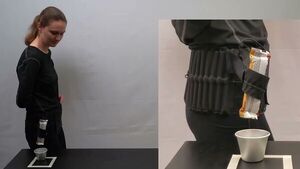
Powering an ‘arm’ with air could be mighty handy
"Walking feeds pressure to pneumatic robots that could help those with disabilities Everybody could use a third arm sometimes, but for some it would be particularly helpful. Mechanical engineers at Rice University’s George R. Brown School of Engineering have built a handy extra limb able to grasp objects and go, powered only by compressed air. It’s one of several ideas they’ve implemented with a textile-based energy harvesting system. The proof-of-principle robotic devices designed and built by Daniel Preston, an assistant professor of mechanical engineering, lead authors Rachel Shveda and Anoop Rajappan and their team are geared toward those living with disabilities and are tough enough for everyday use, they said. How the project described in Science Advances utilizes air differs from the Preston lab’s now-famous manipulation of dead spiders as grabbers. These pneumatic devices derive their power from walking." [...]

MIT chemists develop a wireless electronic lateral flow assay test for biosensing
"Design from the Swager Lab uses electronic polymers, rather than colored lines, to indicate a positive response, enabling quantitative monitoring of biomarkers. Lateral flow assays (LFA) tests have become ubiquitous within the general public; they are the format for standard home pregnancy and Covid-19 tests, indicating a positive result with a colored line, and a negative result with no colored line. In their current iteration, these tests are largely qualitative and binary in their outputs. Various attempts to make a quantitative LFA have yielded complications due to the optical basis of a quantitative test — scattered stray light and faint images. Since Covid has catapulted LFAs into the daily lives of many, the impact of these tests will be even greater if they can be made intrinsically quantitative for the monitoring of key biomarkers associated with disease progression, medical treatments, and basic health monitoring. In a paper published Aug. 17 in the Journal of the American Chemical Society, members of the lab of Professor Tim Swager, led by postdoc Jie Li and graduate student Weize Yuan, reveal the design for a new generation of LFA that uses conductivity (or resistivity) changes in an electronic polymer to create the response." [...]

3D printing is expanding our sustainable building horizons to the outback and beyond
"3D printing processes and building materials can create more sustainable construction in environments as diverse as outback Australia and outer space. A UNSW researcher is pairing traditional building techniques with emerging digital technologies to transform the way we build to contribute to sustainable futures. Dr Kate Dunn from the School of Built Environment is researching how robotics and digital fabrication, such as 3D printing, can lead to more sustainable construction. “I want to build houses with robots and use materials from the [construction] site,” the architectural designer says. “We're looking at really traditional vernacular architecture [that uses local materials and traditional techniques], like mud-brick houses, adobe houses and sustainable materials like hemp. “We’re researching how we can adapt some of those processes, but then optimise them using robotics and new technologies, such as large-scale 3D printing.” Obstacles to building on the Moon and Mars Dr Dunn’s research into old-world techniques has reach, across time and space, quite literally." [...]
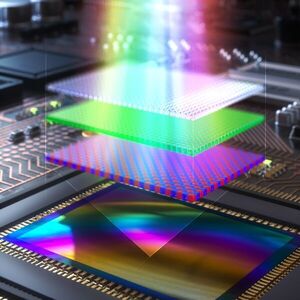
Researchers design highly sensitive, mass producible organic photodetectors
"New green-light absorbing photodetectors could be useful for medical sensors, fingerprint recognition and more Researchers have developed and demonstrated new green-light absorbing transparent organic photodetectors that are highly sensitive and compatible with CMOS fabrication methods. Incorporating these new photodetectors into organic-silicon hybrid image sensors could be useful for applications such as light-based heart-rate monitoring, fingerprint recognition and devices that detect the presence of nearby objects. Whether used in smartphones or scientific cameras, most of today’s imaging sensors are based on CMOS technology and inorganic photodetectors that convert light signals into electric signals. Although photodetectors made from organic materials are attracting attention because they can help boost sensitivity, for example, it has proven difficult to fabricate high-performance organic photodetectors. “For organic photodetectors to be incorporated into mass-produced CMOS image sensors requires organic light absorbers that are easy to fabricate on large scales and can accomplish vivid image recognition and produce distinct images in the dark with a high frame rate,” said Sungjun Park from Ajou University in the Republic of Korea, who co-led the research team. “We developed transparent green-sensitive organic photodiodes that can meet these requirements.” The researchers describe the new organic photodetectors in Optica, Optica Publishing Group’s journal for high-impact research." [...]
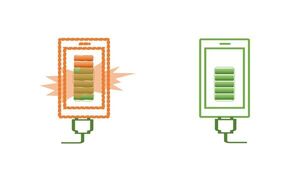
New stable quantum batteries can reliably store energy into electromagnetic fields
"Quantum technologies, i.e. technological devices obtained by building and manipulating quantum mechanical systems, are becoming a reality in recent days. The most prominent example is certainly given by quantum computers, where the unit of information, the bit, is replaced by its quantum mechanical counterpart, informally called the qubit. Contrary to classical computers, quantum computers promise to use the full quantum mechanical features of qubits, in order to address and solve computational problems which would be out of reach by using classical computers. As an example, the Canadian company Xanadu recently claimed that its quantum computer has been able to solve, in just 36 microseconds, a computational task that would have required 9000 years using state-of-the-art supercomputers. Quantum technologies need energy to operate." [...]
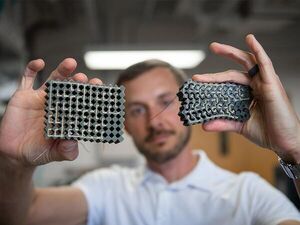
Researchers engineer novel material capable of ‘thinking’
"Someone taps your shoulder. The organized touch receptors in your skin send a message to your brain, which processes the information and directs you to look left, in the direction of the tap. Now, Penn State and U.S. Air Force researchers have harnessed this processing of mechanical information and integrated it into engineered materials that ‘think.’ The work, published today (Aug. 24) in Nature, hinges on a novel, reconfigurable alternative to integrated circuits. Integrated circuits are typically composed of multiple electronic components housed on a single semiconductor material, usually silicon, and they run all types of modern electronics, including phones, cars and robots. Integrated circuits are scientists' realization of information processing similar to the brain's role in the human body. According to principal investigator Ryan Harne, James F. Will Career Development Associate Professor of Mechanical Engineering at Penn State, integrated circuits are the core constituent needed for scalable computing of signals and information but have never before been realized by scientists in any composition other than silicon semiconductors." [...]
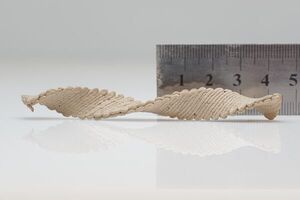
Your next wooden chair could arrive flat, then dry into a 3D shape
"Wooden objects are usually made by sawing, carving, bending or pressing. That’s so old school! Today, scientists will describe how flat wooden shapes extruded by a 3D printer can be programmed to self-morph into complex 3D shapes. In the future, this technique could be used to make furniture or other wooden products that could be shipped flat to a destination and then dried to form the desired final shape. The researchers will present their results at the fall meeting of the American Chemical Society (ACS). ACS Fall 2022 is a hybrid meeting being held virtually and in-person Aug. 21–25, with on-demand access available Aug. 26–Sept." [...]
Documentação
A documentação é parte essencial do processo de aprendizagem e a Internet além de artigos interessantes de explorar também tem alguma documentação em formato PDF interessante de ler. Todos os links aqui apresentados são para conteúdo disponibilizado livremente pelo editor do livro.
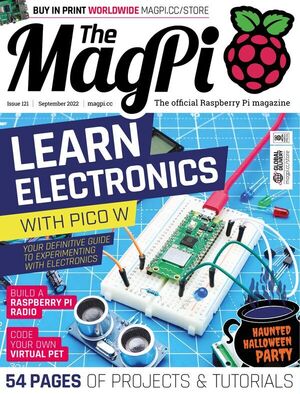
The MagPi 121
"Inside The MagPi magazine issue #121 - Learn Electronics with Pico W. Pair a new Raspberry Pi Pico W with a breadboard and some components and start prototyping circuit boards. - Haunted Halloween Party. Use Raspberry Pi and Pico to power up your party with petrifying creations. - Build a Raspberry Pi Radio. Use Raspberry Pi with a speaker system to play your songs and create your stings and audio indents. - Code your Virtual Pet." [...]
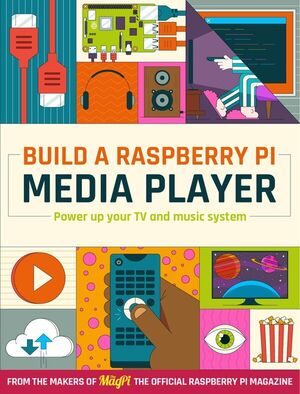
Build a Raspberry Pi Media Player
"Power up your TV and music system with Raspberry Pi: build the ultimate media centre, smart music system, and create a home server. Inside Build a Raspberry Pi Media Player - Create the ultimate media centre. Gather your parts and build your Raspberry Pi media player - Install media player software. How to use RetroPie software for playing games, and add Kodi for media and streaming - Build the ultimate home server. Sharing and storing files on your Raspberry Pi enables you to access them from anywhere in the home - Create an amazing music system. Create a digital jukebox using open-source software - Set up multi-room audio." [...]
Projetos Maker
Diversos Projetos interessantes.
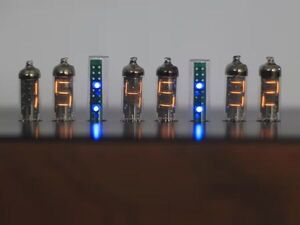
Numitron clock
"Numitron IV-9 clock with RTC 3231 When I was looking on the internet on a website, I saw this nice little display The numitron: I decided to make a clock with the numitrons and I bought six of them. The datasheet says that the current may be between 17 and 22 mA, and the voltage between 2.8 and 4.5 VDC. I am using the shiftregister TLC5916. With only one resistor you can control the output current of all the 8 channels. With a resistor of 1000 Ohm, the constant current is 18.75 mA. In fact the segments of the display are incandescent filaments." [...]

Filament From Bottle
"For a while I’ve been watching PET bottles filament maker projects on YouTube. There are a lot of them, and I have to say, it is a very interesting project and I wanted to make one as well. So, following the same steps and ideas, I’ve made the design, made a schematic for a PCB, 3D printed some parts, made some tests and slowly made my own bottle to filament machine. Right now is not perfect, but at least, does it work? Well, check the post till the end to find out. I’ve made a PCB to go with this project and order it from PCBWAY, and basically, together with an Arduino, it should control the heating block temperature, the feeding speed, maybe a fan, it could also have a display and a control encoder and so on." [...]
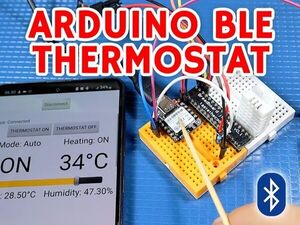
Arduino BLE Thermostat With Mobile App
"Using the XIAO nRF52840 board I created a thermostat that is controlled via Bluetooth Low Energy with no physical controls. A thermostat is the single most beneficial device that one can add to their home so it automatically maintains a steady and comfortable temperature in the home. There are many types and variants of this simple device but in a nutshell, a thermostat is just a temperature-operated switch that controls a heater or a cooler depending on the setup and application. In my example, I made a thermostat that can be attached to a central heating system, like a pellet burner, that can be then controlled via Bluetooth Low Energy from a mobile phone using a custom-built application. The entire project is based on the XIAO nRF52840 BLE board from Seeed Studio and uses a DHT22 sensor to measure the temperature and humidity of the room. Tools and materials used in the project: - XIAO BLE nRF52840 - 5V Single Channel Relay - Mini SPDT Switch - DHT22 Temperature & Humidity Sensor - Mini breadboards - Mini breadboard jumpers - Breadboard jump wires - LiPo Battery - Soldering station - Cheap Android phone" [...]

Arduino based WiFi mobile robot with pan & tilt camera
"This mobile robot with on-board pan & tilt camera can be controlled remotely from a host PC without the need to follow it. This project demonstrates how to use CASP to make a simple WiFi remote controlled 4 wheeled mobile robot that has an on-board WiFi camera mounted on a servos powered pan & tilt assembly. It is manually controlled by the user from host PC through WiFi. Because of the live video from the the on-board camera, the rover need not be in line of sight from the user. This project also uses a custom block (where the source code is available to the user) in the native model. It generates required control signals when user presses certain keys for controlling the movements of the robot." [...]

Connecting Raspberry Pico W to AWS IoT
"Connecting Raspberry Pico W to AWS IoT with micropython is not that hard if you know a few tricks. So lets connect them. When Raspberry Pi Pico W is released it became a new tool which can be used for IoT projects. While its fun to connect our own servers, AWS is an established enterprise ecosystem which every IoT enthusiast should have some experience on and Pico W gives us an cheap development board to get our feet wet. Some of AWS requirement seems to be overkill at first but it they will become useful as your project progress. So lets get started" [...]
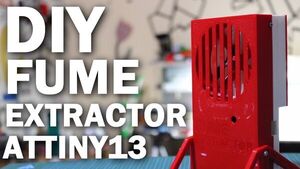
Fume Extractor
"Made a Fume Extractor by using a custom Attiny13 Based Motor driver board and 3D Printed Body, Greetings. So here's something COOL, a DIY Fume Extractor made completely from scratch. Its body is made up of 3D Printed parts and the motor controller is based on Attiny13 MCU that uses a Mosfet IC to control the Motor Via PWM Signal that we control with a button. It has three modes for working, One first button press, Motor Runs at 100% Speed. The second Button press reduces the motor Speed by up to 50%, Third Press turns Motor OFF. It is powered by a single 3.7V 2200mAh Lithium Cell and uses a Micro Drone Motor as Exhaust Fan and its backup is more than 4 hours in 100% Mode and 8 Hours in 50% Mode." [...]
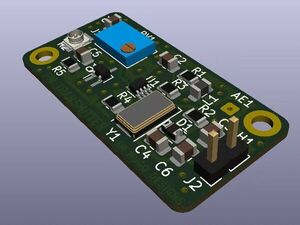
FM Transmitter System Board
"In this project, we have designed an FM broadcasting transmitter system with a bandwidth of about 433MHz suitable for radio broadcasting. This is the simplest form of FM transmitter which has the capability of transferring broadcasted music or voice to a range of 50m depending on the type of antenna that has been used. The system works without the requirement of tuning and the crystal quarts used are locked to a maximum of 90MHz. This system can eliminate frequency drift which is a common effect of modern LC-based transmitter systems. The system is built around low power audio amplifier LM386, PN2222Atransistor, 1SV149 varactor diode, 30MHz crystal quartz, and several other components like potentiometer, diodes, capacitors, and resistors. The tank circuit built at the collector of PN2222A which is made up of inductor L1 and capacitor C5 has a tuning of 3 times what the crystal quartz is rated which is 90MHz." [...]
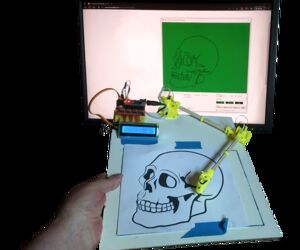
Tim's Electronic Pantograph
"This is part two of my Hall-Effect Sensor Trilogy. It is best to read the first part if you haven't first: Tim's Electronic Dividers [1D] : 13 Steps (with Pictures) - Instructables In this instructable I will be using two 49E Sensors, each with two magnets in the same way I used them with the Dividers. A 3D Printer is needed for this one, as the accuracy of construction is definitely a key element. I will be using an Arduino NANO as before with an LCD to show coordinates, but to do something practical with the output an application is required to give a graphical representation of the data. I have made an application to do this. This project requires: The basic understanding of the Arduino Platform." [...]
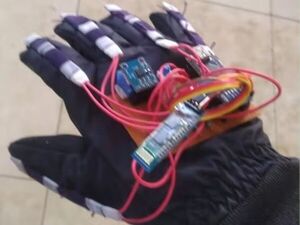
Simple smart Glove for deaf peoples
"A smart glove for deaf peoples Story Smart hand gloves help physically disabled people to communicate with normal people. As Dump person cannot speak then this smart gloves helps him to convert this hand gesture into text or pre-recorded voice. This also help normal person to understand when he is trying to say and do accordingly this smart gloves has facility of home appliance control from which a physically impaired person become independent to live the main objective or the implemented paper is to develop a reliable easy to use light weight. Smart hand gloves system which can minimize the obstacles for disabled people. " [...]

Touch Me! Open Universal Input Sleeve {OUIS}
"I love fabric! I really love conductive fabric, so if you've never used conductive fabric, I hope you sew and enjoy this Instructable. Conductive fabric is fabric that conducts electricity. Typically there are metal strands woven into the fabric, or the metal strands might be woven with other fabrics, such as polyester. Making e-textiles, wearables, and soft circuits often use conductive fabrics for a variety of projects. What are we making?" [...]
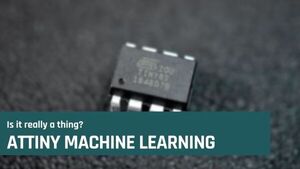
Is it really a thing? Attiny Machine Learning
"David raises a question worth investigating: RAM constraints of the Attiny chip. RAM is indeed the most limiting factor on many boards as it dictates how much data you can hold in memory at any given time. Until recently, most microcontrollers had RAM memory ranging from 2 Kb (Arduino UNO) to 8 Kb (Arduino MEGA). Many other microcontrollers were in the same ballpark. Nowadays we experienced a huge leap forward and boards come equipped with up to 512 Kb of RAM. Nevertheless, for many neural network models, this proves to be still a constraint." [...]

Drawing Filled Quadrilaterals and Triangles
"This is an extension to my graphics libraries to plot filled quadrilaterals and triangles. It is designed for use with my colour TFT graphics library, Tiny TFT Graphics Library 2. With one minor change it can also be used with the version of that library that supports reading from supported TFT displays, Reading from a TFT Display. It will probably also work with other graphics libraries. The triangle and quadrilateral plotting routines share much of the same code, so the resulting routines are quite compact, and should fit on microcontrollers with limited memory. You may wonder why I didn't just write a routine to plot filled triangles, and then draw quadrilaterals as two adjacent triangles." [...]
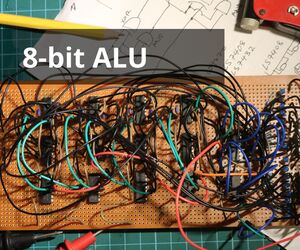
8-bit ALU (Arithmetic Logic Unit)
"In this Instructable, I will be going through the process of building and understanding the architecture behind an ALU (Arithmetic Logic Unit). The ALU is part of a computer's CPU (central processing unit) and it handles arithmetic and logic operations as the name suggests. The ALU that we will be building is a far simpler version than what may exist on your computer. More complicated ALUs may handle 64-bit numbers and have many more functions than just addition and subtraction. The ALU that will be discussed here will only be able to perform addition and subtraction on 8-bit numbers and will be built from 74HC logic using XOR, AND, and OR gates. All of which will be explained in detail in this instructable." [...]

DIY Aduino One Axis Self Balancing Device
"Simple to build one axis self stabilizing device witch consist only three components Arduino nano, Nem24 brushless motor, and MPU6050. This time I will show you how to make a simple One axis self balancing device, which is based on the PID control system. A proportional–integral–derivative controller is a control loop mechanism employing feedback that is widely used in industrial control systems and a variety of other applications requiring continuously modulated control. A PID controller continuously calculates an error value as the difference between a desired setpoint and a measured process variable and applies a correction based on proportional, integral, and derivative terms. In our case, the MPU6050 sensor collects data of the position (more precisely the angle) of the device, and sends that data to the microcontroller which performs calculations based on previously given algorithms and constants, and sends the result to the electric motor, which with its movement tends to hold the device in the desired position. This loop is performed very quickly so that the device is stable in a vertical position." [...]

Battery operated thermometer with connection to BLYNK
"self-sufficient with battery operation and multi-wifi support This device measures the temperature and is self-sufficient from a power supply. It uses a rechargeable battery with 1.100 mAh and 3.7V. With the deep sleep modus of the WEMOS mini it can sustain operation for a period of 10 days. The WEMOS Mini, the DS 18B20 and the battery shield are attached on a dual shield. In order to be able to measure the voltage, it is necessary to attach a 100 kilo ohm resistor between the positive pole and the input a0 on the battery shield. " [...]
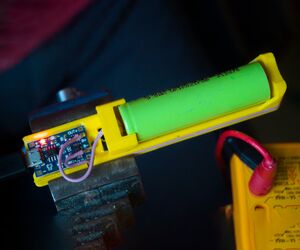
Single 18560 Battery Charger With TP4056
"Hi guys, in this article we will see how to make a very convenient single charger for 18650 cells so that you don't always have to arrange homemade tools like magnets or things like that to hook into the two poles but use this cute 3D printed design that allows us to charge our cell with a very simple micro-USB cable through a module with the integrated TP4056 inside But now, as always, get comfortable and let's see what we need to build it ... Supplies - 3D printed piece (so you need a 3D printer - 20 cm of electrical wire with a minimum of 1A - Module with integrated TP4056" [...]
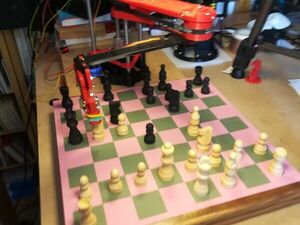
SCARA Chess Robot
"It uses a 3D printed SCARA robot arm from free resources with my code to recognise the human moves and control the arm I previously made a Cartesian chess playing robot arm - and wanted to make a 3d-printed SCARA arm play chess too. It works like this: The human, playing white, makes a move. This is detected by the visual recognition system. The robot then ponders and then makes its move. And so on... Perhaps the most novel thing in this robot is the code for move recognition. Because the human's move is recognised by a vision system, no special chess board hardware (such as reed switches, or whatever) is needed." [...]
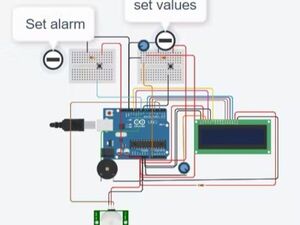
Alarm clock without RTC
"Don't you think today's alarm clocks are too convenient to avoid?This clock that I designed makes you get out of your bed just to stop it. I used to face difficulty waking up early in the morning. So I planned to create an alarm clock which can only be deactivated if I move for a fixed period of time infront of it. This model uses a PIR sensor to detect movement, and turns off the alarm buzz only after it detects movement for certain period of time. " [...]
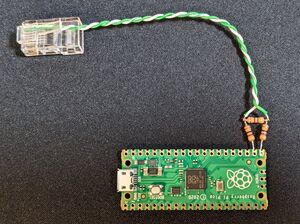
Pico-10BASE-T
"10BASE-T from Raspberry Pi Pico Note: - DO NOT CONNECT to PoE equipment!! - Currently transmission only (UDP is available) - Receiving process will be implemented in the future... - It is advisable to insert a pulse transformer for safety. Setup - Raspberry Pi Pico - 2 x 47 ohm resistor - 1 x 470 ohm resistor - RJ45 connector(GP16 = TX-, GP17 = TX+)" [...]

Analog style POV Clock using magicbit-(ESP-32)
"In this project, we will make an analog-style POV clock. This is a fun project that you can do very easily at home. Story In this project, we will make an analog-style POV clock. This is a fun project that you can do very easily at home. The way you connect the wires and place the components could be different from the method we have shown below and it is totally fine! You will be okay if you follow the circuit diagram and follow the instructions properly." [...]

Adam74
"Something that struck me reading about the history of the Apple I computer was the fairly simple “ASCII bus” that it used for input and output. As I understand it a hobbyist back in the day could get an ASCII keyboard that quite literally presented as an interface a header giving 7-bits of ASCII and an additional strobe pin that indicated that a key had been pressed. Press the “A” key on the keyboard and the 7-bits representing the letter “A” in ASCII would be set high/low on 7 output pins and the strobe pin would momentarily go high. Needless to say, the Apple I was wired up in such a way that when the strobe pin pulsed it would immediately fetch the 7-bits of ASCII from the keyboard. And just as simply, to display a character the Apple I would output ASCII in the same manner. In the output case, another device similar to the TV Typewriter would look for a similar “strobe” and push the character into a buffer that was constantly being read from and displayed to a television display." [...]
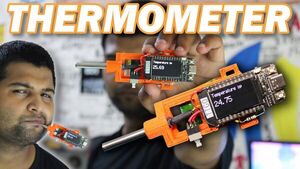
DIY Thermometer with TTGO T Display and DS18B20
"Made a custom 3D Printed Thrmeometer from Scratch using TTGO T Display and DS18B20 Sensor. So this is the DIY Thermometer made entirely from scratch using a TTGO T display board and DS18B20 Temp sensor. A 3D Printed body is being used to hold everything together, for Version 1, I've made an exoskeleton-like body that holds a display on one side and a lithium cell on the other. This DIY Thermometer is easy to make and just uses a couple of components that we can easily get and replicate this device. This article is about the whole built Process of this device so let's get started. MATERIAL REQUIRED These are the materials that were used in this built- - TTGO T DISPLAY - DS18B20 Sensor - 3D Printed Parts - ON OFF SWITCH - LiPo Cell - Breadboard and jumper wires" [...]

A precise linear magnetic position sensor using LInterp
"Virtualise a non-linear sensor into a single linear function using the LInterp PROGMEM array generator This tutorial shows you how to "Virtualise" a non-linear magnetic position sensor to produce an accurate linear position measurement from a single function call. It uses the LInterp array generator described in the ProjectHub tutorial "LInterp - A linear interpolation PROGMEM array generator" to produce a linear translation array for the sensor in program-space memory (PROGMEM). The resulting sensor measurement function uses no RAM storage. This scheme works on any Arduino board. A simple magnetic position sensor A Hall-effect magnetic flux sensor such as the Allegro Microsystems UGN3503 used in this tutorial makes an excellent contact-free short-range position sensor when used with a small rare-earth magnet positioned on the moving part being monitored. It is ideal where a position sensor must be fitted to existing equipment non-invasively (apart from a static magnetic field) or where a mechanical sensor would offer too much motive resistance." [...]

USB Power Injector
"The USB Power Injector allows a convenient way to power up USB 2.0 devices from a lab power supply, while still allowing data transfer. When powering devices from a standard USB 2.0 port, either from a PC or from a standard USB hub, you never have the niceties that an adjustable lab style power supply has. During development that means you can’t set precise voltage and current limits. In the best case scenario, that means you can’t test under/over voltage protections. In the worst case, you run excessive current trough your device and you don’t even know that’s happened.USB hubs tend to have overcurrent protection, but most don’t send the overcurrent event to the operating system.That can cause confusion and loss of time for a hardware engineer during development or to testing personnel during production.This project allows a way to conveniently power a USB2.0 device from a lab power supply and thus avoiding the problems described above. The schematic for this project is quite simple." [...]

Simple fine-drawn analog and word CLOCK ON E-PAPER
"3.7" E paper shows time synchronized at powerup in the style of an analog clock as well as of the corresponding group of words. The display which is connected to the ESP32 via SPI Interface, is driven with the GxEPD2 library and the fonts are provided by the U8g2_for_Adafruit_GFX library whose methods work inside the picture loop (paged drawing) of GxEPD2. The time information is received from a public ntp (network time protocol) server in the setup and then copied to the time structure (struct tm) named timeinfo in updateTime(). Admittedly I have zero knowlegde in programming and thus the synchronization of the time could be programmed much more effectively and smart. I used the strftime function to generate three strings for hour, minute and second and then converted them back to integers. Once at start the number of seconds at this moment is then subtracted from the minute the clock normally waits until it updates the time to the next minute and refreshes the display." [...]
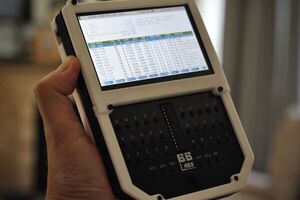
HandiPi
"Handheld RPI4 based computer with 36-key tactile keyboard and display What is it? Glad you asked.. it's a fully functional linux computer with: A Raspberry Pi 4 Custom 36-key keyboard with 5 way directional buton based around an Atmega328 4.3" DSI touchscreen display PiSugar power controller with 5000mah battery It runs for about 4 hours with general terminal use and is pretty useful on it's own, but you can hook up external monitors and other USB peripherals if you need more screen or typing space. " [...]

PWM Controller with R/E
"Last month I spent quite a lot of time on expansion modules for use with the ESP-12E I2C Base Card. While the system worked exceptionally well as a prototyping and firmware testing platform ( as originally intended ), I immediately saw that the physical size of everything ( base board, with the cards) would be a problem inside any enclosure, when used with a real-world project. At the same time, I have an ongoing need to design and manufacture a device for a friend, that will have very limited space inside the enclosure due to other essential components. I have thus decided to combine the functionality of two of the IO Expander cards into a more compact design, on a single PCB ( Which I plan to use to power and control an Air Assist blower on my desktop CNC/Laser cutter, as well as function as a next step prototype for my other project. " [...]
Secção Videos
Videos interessantes.
That's all Folks!



